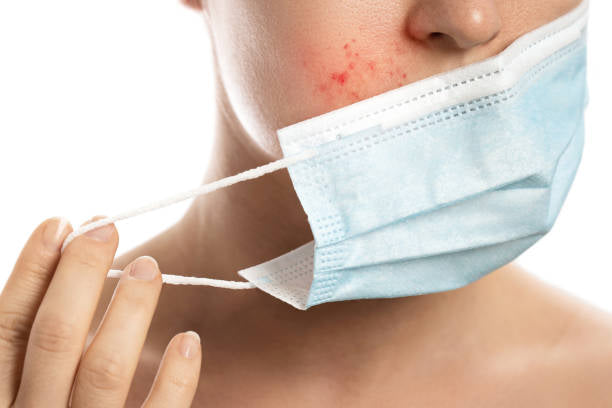(a) Inventory of symptoms and main causes of “mask muscle”
Under the epidemic, masks have become an indispensable daily necessities for people. Whether they are going to work or watching movies, they must wear masks whenever they go out. Over time, the skin can not breathe freely, skin quality deteriorates, sensitive redness, constant oil, pimples and acne, all find the door! If you have the above difficulties, may have been deeply affected by the "mask muscle"! This article will take you to know What is mask muscle—inventory of symptoms and causes of mask generation.
What exactly is "mask muscle"? Because people now wear masks for long periods of time when going out every day, facial skin is prone to pressure damage; and the disposable masks we commonly use have set up layers of barriers to prevent the invasion of germs, causing a gap between the facial skin and the mask. The ambient temperature and humidity rise, causing a series of skin problems, which are collectively referred to as "mask skin" in English.
The main symptoms and main causes of "mask muscle"
Symptom 1: Acne and pimples occur frequently. As mentioned above, a humid and hot skin environment can easily lead to excessive secretion of sebaceous glands. Therefore, the amount of oil produced by the skin is greatly increased, and the sebum cannot be discharged, blocking pores and forming closed acne. At the same time, a closed environment is more likely to cause acne. Provides a breeding ground for some acne-causing bacteria, such as Malassezia, Propionibacterium acnes, etc. Microorganisms and bacteria on the surface of the skin multiply in large numbers, thus inducing or aggravating the original inflammation of the base of some sensitive skin, resulting in red and swollen acne.
Symptom 2: Facial skin conditions vary. Many people think that after wearing a mask, most of the facial skin is covered by the mask, so there is no need for additional facial sun protection. However, the forehead and around the eyes, etc., are still exposed to the sun. When exposed to ultraviolet rays, it is difficult to avoid uneven skin tone, oxidation and photoaging in facial areas.
Symptom 3: Redness and itching on the face. Wearing a mask for a long time increases the contact and friction between the face and the mask, which can easily damage the surface of the skin and cause pressure damage; mask materials that are not skin-friendly such as non-woven fabrics, elastic bands, and aluminum Plastic strips, etc., can irritate the skin and cause contact dermatitis, causing redness and allergies, and even cause eczema. In addition, the rising temperature inside the mask will cause capillary blood vessels to expand, making the red blood streaks on the face more obvious.
*
Symptom 4: Damaged skin barrier The sebum membrane and stratum corneum of the skin form a natural barrier for us. Among them, the sebaceous gland is the outermost protective film of the skin. It is composed of sebum and sweat and has antibacterial and moisturizing effects. The stratum corneum is composed of old and waste cells, which can effectively reduce the loss of skin moisture. The characteristics of barrier damage include: dry and flaky skin, rough itchiness, sensitivity and redness, etc. The reasons for barrier damage caused by wearing a mask for a long time are as follows:
1. Repeated physical friction between the mask and the skin will destroy the protective effect of the stratum corneum itself.
2. The closed skin environment prevents water from evaporating in time, and the humidity is too high. The stratum corneum is immersed in water vapor, causing swelling, causing damage to the cell barrier, ineffectiveness of its water-locking function, and accelerated skin water evaporation.
Impaired skin barrier is also the main culprit of repeated and difficult-to-cure skin problems caused by "mask skin": Because the skin barrier cannot function normally, its ability to retain moisture and resist external stimulation is reduced, making facial skin more sensitive and fragile , it is even more difficult to adapt to the humid and high-temperature environment inside the mask, which aggravates various symptoms of "mask muscle". In addition, although the skin itself has the ability to repair itself, wearing a mask for a long time is not conducive to the skin's self-healing. Coupled with repeated acne breakouts and inflammation problems, it eventually creates a vicious cycle and makes it difficult to get rid of the sequelae of mask skin.
In addition to the main causes of "mask skin" described above, what other factors can easily lead to similar skin problems?
1. Skin type:
Compared with dry and normal skin, oily and sensitive skin are more susceptible to "mask skin". The former has more facial oil secretion than other skin types, so it is more likely to clog pores and form acne. The closed, hot and humid environment while wearing a mask for a long time will further worsen the original acne problem of this type of skin; The stratum corneum of patients is relatively thin and easily damaged. Their skin resistance is low, making it easier for such skin problems to take advantage of.
2. Hygiene issues:
If you don’t have the habit of changing masks regularly and checking the usage of the mask, wearing the same mask for a long time will reduce the water absorption capacity of the innermost layer of the mask, making the skin environment more humid; dust and dirt inadvertently inhaled will accumulate inside and breed bacteria. It also prevents the air from flowing smoothly.
3. Inappropriate skin care methods:
When the mask is closed, the amount of oil produced by the skin increases, so many people will increase the frequency of face washing, increase the cleaning intensity, and choose to use cleansing products with strong oil removal capabilities, hoping to wash away the oil and remaining dirt on the face. However, long-term use of cleansing products with too strong cleaning power and vigorous rubbing of the facial skin will have the opposite effect, causing over-cleansing and damaging the sebum film.
4. Seasonal changes:
As the seasons change, the skin becomes more fragile! Seasonal allergies such as spring sensitivity (commonly known as spring sensitivity) and summer measles can cause similar skin problems such as redness, peeling, and itching.
The hot summer is coming, and the humid and muggy weather in Hong Kong is even worse for "mask skin". How to effectively combat the problem of "mask skin"? Please visit: blog2 link


 Whatsapp us!
Whatsapp us!